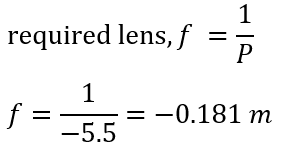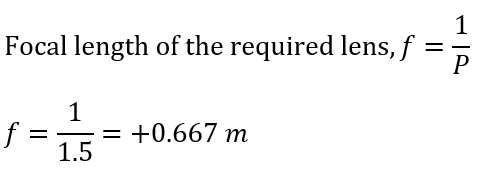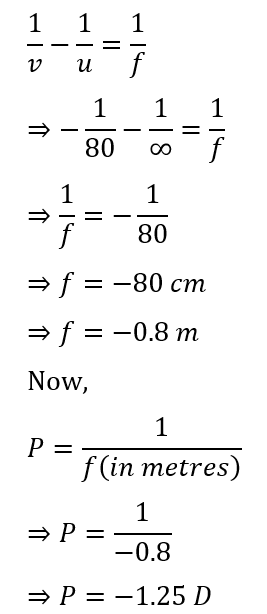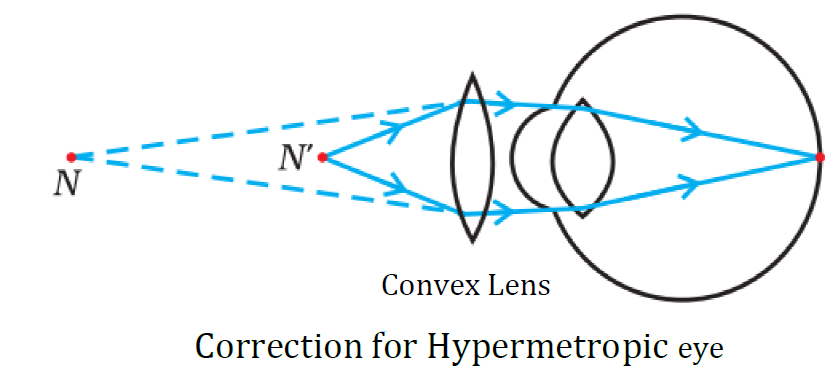NCERT Solutions for Class 10 Science Chapter Chapter 10 Human Eye and Colourful World includes latest edition answers of intext & exercise questions. All these NCERT solutions are prepared by expert teachers with detailed explanations of every important topic. It is important for the students to go through these NCERT solutions to get knowledge of the type of question asked on Human Eye and Colourful World chapter.
NCERT Solutions for Class 10 Science Chapter 10 Intext Questions
Page No. 164
Question 1: What is meant by power of accommodation of the eye?
Answer: The power of accommodation of the eye refers to its ability to change the focal length of its lens. This allows the eye to focus on objects at different distances, ensuring that images appear clear and sharp on the retina. When you look at something close, the lens becomes thicker to focus the light correctly. When looking at distant objects, the lens flattens. This flexibility of the lens is crucial for clear vision at various distances.
Question 2: A person with a myopic eye cannot see objects beyond 1.2 m distinctly. What should be the type of the corrective lens used to restore proper vision?
Answer: The person is able to see nearby objects clearly, but he is unable to see objects beyond1.2 m. This happens because the image of an object beyond 1.2 m is formed in front of the retina and not at the retina, as shown in the given figure.

To correct this defect of vision, he must use a concave lens. The concave lens will bring the image back to the retina as shown in the given figure.

Question 3: What is the far point and near point of the human eye with normal vision?
Answer: The near point of the eye is the minimum distance of the object from the eye, which can be seen distinctly without strain. For a normal human eye, this distance is 25 cm. The far point of the eye is the maximum distance to which the eye can see the objects clearly. The far point of the normal human eye is infinity.
Question 4: A student has difficulty reading the blackboard while sitting in the last row. What could be the defect the child is suffering from? How can it be corrected?
Answer: A student has difficulty in reading the blackboard while sitting in the last row. It shows that he is unable to see distant objects clearly. He is suffering from myopia. This defect can be corrected by using a concave lens.
NCERT Solutions for Class 10 Science Chapter 10 Exercise Questions
Question 1:The human eye can focus objects at different distances by adjusting the focal length of the eye lens. This is due to
(a) presbyopia
(b) accommodation
(c) near-sightedness
(d) far-sightedness
Answer: (b) accommodation
Human eye can change the focal length of the eye lens to see the objects situated at various distances from the eye. This is possible due to the power of accommodation of the eye lens.
Question 2: The human eye forms the image of an object at its
(a) cornea
(b) iris
(c) pupil
(d) retina
Answer: (d) retina
The human eye forms the image of an object at its retina.
Question 3: The least distance of distinct vision for a young adult with normal vision is about
(a) 25 m
(b) 2.5 cm
(c) 25 cm
(d) 2.5 m
Answer: (c) 25 cm
The least distance of distinct vision is the minimum distance of an object to see clear and distinct image. It is 25 cm for a young adult with normal visions.
Question 4: The change in focal length of an eye lens is caused by the action of the
(a) pupil
(b) retina
(c) ciliary muscles
(d) iris
Answer: (c) ciliary muscles
The relaxation or contraction of ciliary muscles changes the curvature of the eye lens. The change in curvature of the eye lens changes the focal length of the eyes. Hence, the change in focal length of an eye lens is caused by the action of ciliary muscles.
Question 5: A person needs a lens of power −5.5 dioptres for correcting his distant vision. For correcting his near vision he needs a lens of power +1.5 dioptre. What is the focal length of the lens required for correcting (i) distant vision, and (ii) near vision?
Answer 5: (i) For distant vision = −0.181 m, for near vision = 0.667 m.
The power of a lens of focal length f is given by the relation

Power of the lens used for correcting distant vision = − 5.5 D Focal length of the

The focal length of the lens for correcting distant vision is −0.181 m.
(ii) Power of the lens used for correcting near vision = +1.5 D

The focal length of the lens for correcting near vision is 0.667 m.
Question 6: The far point of a myopic person is 80 cm in front of the eye. What is the nature and power of the lens required to correct the problem?
Answer: The person is suffering from an eye defect called myopia. In this defect, the image is formed in front of the retina. Hence, a concave lens is used to correct this defect of vision.
Object distance, u = infinity = ∝,
Image distance, v = −80 cm
Focal length = f
According to the lens formula,

A concave lens of power −1.25 D is required by the person to correct his defect.
Question 7: Make a diagram to show how hypermetropia is corrected. The near point of a hypermetropic eye is 1 m. What is the power of the lens required to correct this defect? Assume that the near point of the normal eye is 25 cm.
Answer: A person suffering from hypermetropia can see distinct objects clearly but faces difficulty in seeing nearby objects clearly. It happens because the eye lens focuses the incoming divergent rays beyond the retina. This defect of vision is corrected by using a convex lens. A convex lens of suitable power converges the incoming light in such a way that the image is formed on the retina, as shown in the following figure.

The convex lens actually creates a virtual image of a nearby object (N’ in the figure) at the near point of vision (N) of the person suffering from hypermetropia.
The given person will be able to clearly see the object kept at 25 cm (near point of the normal eye), if the image of the object is formed at his near point, which is given as 1 m.
Object distance, u = −25 cm
Image distance, v = −1 m = −100 cm
Focal length = f
Using the lens formula,

A convex lens of power +3.0 D is required to correct the defect.
Question 9: What happens to the image distance in the eye when we increase the distance of an object from the eye?
Answer: When an object moves farther away from the eye, the eye’s lens adjusts its shape to focus the light properly on the retina. The lens becomes less curved, or flatter, to focus the parallel rays coming from the distant object. Due to these adjustments in the lens, even when we increase the distance of an object from the eye, the distance where the image forms on the retina (the image distance) stays nearly the same. This consistent image distance is essential for maintaining a clear and focused image on the retina, regardless of how far away the object is.
Question 10: Why do stars twinkle?
Answer: Stars twinkle because of the Earth’s atmosphere. When light from a star travels through space, it moves in a straight line. But as soon as this light enters the Earth’s atmosphere, it passes through layers of air with varying temperatures and densities. This causes the light to bend, a phenomenon known as refraction.
Since the atmosphere is always moving, the light from the star is bent in different directions over time. This makes it seem like the star is changing in brightness and position, which we perceive as twinkling. This effect is more noticeable for stars near the horizon since their light passes through more atmospheric layers compared to stars overhead.
Question 11: Explain why the planets do not twinkle?
Answer:
Planets don’t twinkle like stars because they are much closer to Earth and appear larger in the sky. When light from a planet enters Earth’s atmosphere, it also gets refracted by the different layers of air, just like starlight. However, because planets are closer and appear as small disks rather than points of light, the effects of atmospheric turbulence are averaged out.
The light from a planet comes from a larger area, so even though parts of it are bending and flickering, other parts remain steady. This averaging effect means the overall light from the planet appears constant to our eyes, so we don’t see the twinkling effect that we do with the much more distant, point-like stars.
OR
Planets do not twinkle like stars because their apparent size in the night sky is larger due to their relative closeness to Earth. When light from a planet passes through Earth’s atmosphere, it is subject to the same refractions and disturbances that cause stars to twinkle. However, because planets are closer and appear as small disks rather than point sources of light, the various refracted light rays tend to average out. This blending of light reduces the twinkling effect, making the planets appear to shine with a steady light. In contrast, stars are so distant that they appear as point sources, and the atmospheric disturbances cause their light to flicker, leading to the twinkling effect.
Question 12: Why does the sky appear dark instead of blue to an astronaut?
Answer: The sky appears dark instead of blue to an astronaut because there is no atmosphere in space to scatter sunlight. On Earth, the sky appears blue because the atmosphere scatters the shorter blue wavelengths of sunlight more than the red wavelengths. In space, without an atmosphere to scatter the light, the sky looks dark, and the stars are visible even during what would be daylight hours on Earth.
Question 13: Why does the Sun appear reddish early in the morning?
Answer: The Sun appears reddish early in the morning due to the scattering of light by the Earth’s atmosphere. When the Sun is near the horizon, its light has to pass through more of the Earth’s atmosphere compared to when it is overhead. The atmosphere scatters shorter wavelengths of light (like blue) more than longer wavelengths (like red). So, when the Sun is low in the sky, more of the blue light is scattered out of the direct path to our eyes, and the longer red wavelengths dominate, making the Sun look reddish.